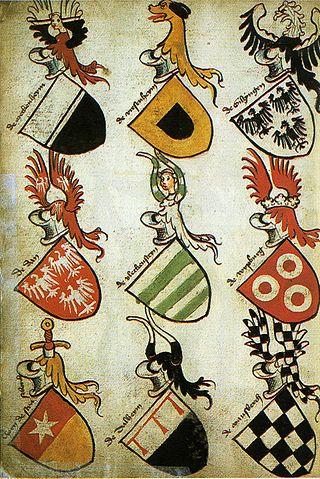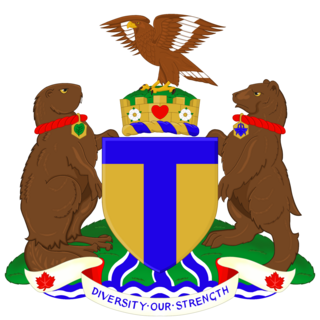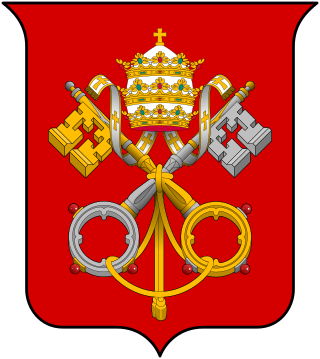
Heraldry is a discipline relating to the design, display and study of armorial bearings, as well as related disciplines, such as vexillology, together with the study of ceremony, rank and pedigree. Armory, the best-known branch of heraldry, concerns the design and transmission of the heraldic achievement. The achievement, or armorial bearings usually includes a coat of arms on a shield, helmet and crest, together with any accompanying devices, such as supporters, badges, heraldic banners and mottoes.

The coat of arms of Toronto is a heraldic symbol used to represent the city Toronto. Designed by Robert Watt, the Chief Herald of Canada at the time, for the City of Toronto after its amalgamation in 1998. The arms were granted by the Canadian Heraldic Authority on 11 January 1999.

The coat of arms of Romania was adopted in the Romanian Parliament on 10 September 1992 as a representative coat of arms for Romania. The current coat of arms is based on the lesser coat of arms of interwar Kingdom of Romania, which was designed in 1921 by the Transylvanian Hungarian heraldist József Sebestyén from Cluj, at the request of King Ferdinand I of Romania, it was redesigned by Victor Dima. As a central element, it shows a golden aquila holding a cross in its beak, and a mace and a sword in its claws. It also consists of the three colors which represent the colors of the national flag. The coat of arms was augmented on 11 July 2016 to add a representation of the Steel Crown of Romania.

The coat of arms of Hungary was adopted on 3 July 1990, after the end of communist rule. The arms have been used before, both with and without the Holy Crown of Hungary, sometimes as part of a larger, more complex coat of arms, and its elements date back to the Middle Ages.

There are two coats of arms in official use in the Autonomous Province of Vojvodina, the coat of arms of Vojvodina and the Traditional coat of arms of Vojvodina. Two coats of arms are given the equal status in the Provincial Assembly Decision on the Appearance and Usage of Symbols and Traditional Symbols of AP Vojvodina adopted in 2016.

The personal papal coat of arms of Pope Benedict XVI was designed by Archbishop Andrea Cordero Lanza di Montezemolo soon after the papal election in 2005.

The coat of arms of the Czech Republic is divided into two principal variants. Greater coat of arms displays the three historical regions—the Czech lands—which make up the nation. Lesser coat of arms displays lone silver double-tailed lion in red shield. The current coats of arms, which was adopted in 1992, was designed by Czech heraldist Jiří Louda.

The coat of arms of Denmark has a lesser and a greater version.

The coat of arms of Portugal is the main heraldic insignia of Portugal. The present model was officially adopted on 30 June 1911, along with the present model of the Flag of Portugal. It is based on the coat of arms used by the Kingdom of Portugal since the Middle Ages. The coat of arms of Portugal is popularly referred as the Quinas.

In heraldry and heraldic vexillology, a blazon is a formal description of a coat of arms, flag or similar emblem, from which the reader can reconstruct the appropriate image. The verb to blazon means to create such a description. The visual depiction of a coat of arms or flag has traditionally had considerable latitude in design, but a verbal blazon specifies the essentially distinctive elements. A coat of arms or flag is therefore primarily defined not by a picture but rather by the wording of its blazon. Blazon is also the specialized language in which a blazon is written, and, as a verb, the act of writing such a description. Blazonry is the art, craft or practice of creating a blazon. The language employed in blazonry has its own vocabulary, grammar and syntax, which becomes essential for comprehension when blazoning a complex coat of arms.

The German state of Brandenburg has a coat of arms depicting a red eagle.

The coat of arms of Kropyvnytskyi is one of the city's symbols reflecting its past and the controversies of its history.

This article is about the coat of arms of the German state of Saarland.
Árpád stripes is the name of a particular heraldic and vexillologic configuration which has been in constant use since the early 13th century in particular in Hungarian heraldry. It can be seen in the left half of the current coat of arms of Hungary.

The coat of arms of Dalmatia is the heraldic symbol used for the historical region of Dalmatia on the eastern coast of Adriatic Sea. It is also featured on the crest of the coat of arms of Croatia.

The coat of arms of the Holy See combines two crossed keys and a tiara, used as a coat of arms by the Holy See. These forms have origins attested from the 14th century. The combination of one gold and one silver key is a somewhat later development.

German heraldry is the tradition and style of heraldic achievements in Germany and the Holy Roman Empire, including national and civic arms, noble and burgher arms, ecclesiastical heraldry, heraldic displays and heraldic descriptions. German heraldic style is one of the four major broad traditions within European heraldry and stands in contrast to Gallo-British, Latin and Eastern heraldry, and strongly influenced the styles and customs of heraldry in the Nordic countries, which developed comparatively late. Together, German and Nordic heraldry are often referred to as German-Nordic heraldry.

The coat of arms of Colchester City Council is the coat of arms granted to Colchester City Council, which is the local authority for the district of Colchester, Essex, England. The arms were first granted by Henry V in 1413.

Icelandic heraldry is the study of coats of arms and other insignia used in Iceland. It belongs to the German-Nordic heraldic tradition, as the heraldry of Iceland has been primarily influenced by the heraldic traditions of Norway, Denmark and other Nordic countries. Iceland does not have a strong sense of heraldic tradition, however, because the country lacks a governing body to oversee this. As a result, coats of arms registered as such are virtually nonexistent in modern Iceland. While many municipalities use more or less heraldic logos, there are no heraldic standards to which these must adhere, and they are registered as graphic designs rather than as coats of arms.
In heraldry, a mount is a representation of a hill or mountain as a curved terrace in base. When the mount is included in the lower part of the shield, it may be considered an ordinary rather than a charge.


















